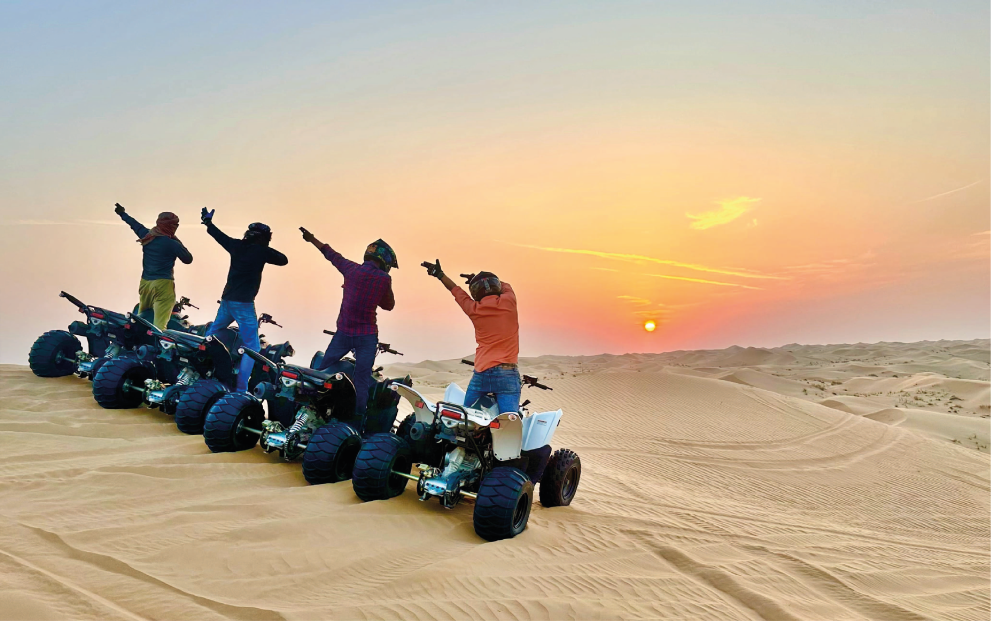Desert Wildlife Encounters a desert in Dubai is not simply a piece of geography. What is also vibrant with life is uniquely (and sometimes ridiculously) Australian fauna, which are all specifically adapted to the conditions. You may also be on an exciting desert buggy tour or literally driving the buggies through the sand and across the dunes in Dubai and meet some quite fascinating creatures. Well, this is a nice reference to some of the animals or some of the wildlife that you can encounter around the desert, even in Dubai.
Arabian Oryx
Arabian Oryx is one of the mascot animals prevalent in UAE, and it has been felt in the conservation program. These antelopes have come almost to extinction in the recent past but are some of the most well-revived creatures of this century, according to conservationists. Arabian Oryx has white body coloration and long, thin, spiral horns; they are adapted to live in the deserts. The best way to see them is by free-ranging in the wild or in the protected reserves of the Dubai Desert Conservation Reserve.
Sand Gazelle
The other native creature that inhabits the deserts of Dubai is the Sand Gazelle, which is also referred to as the Gazelle of Arabia. These graceful animals have thin limbs and similar sand sepia-colored fur. These small animals, like Sand Gazelles, are normally found in small groups, and they can afford to outdistance evil predators.
Arabian Red Fox
The smaller nocturnal Arabian Red Fox does not grow as significantly but is a fierce predator that has succeeded in adapting to the harsh conditions of desert living. This is a hunting soil and stretch of this lovely Fox / Long tongue, which uses its red fur with pronounced ear filaments in the search for tiny exoskeletons. Although mainly active during evenings, you can see these foxes at dawn or dusk.
Desert Monitor Lizard
The Desert Monitor Lizard is a giant lizard that can live and grow well under Dubai’s hot, arid conditions. These lizards can easily reach up to a length of 1.5 meters and have solid legs with high power-carrying feet. They also possess long tails covering their back while sleeping in burrows from predators so that it becomes more difficult for them to catch the iguana species. They are usually discovered on the shore, burrowing in the sand or sunning themselves & for a wildlife enthusiast, happening upon one could be quite an experience.

Arabian Horned Viper
Known for its superb bright coloration yet deadly nature on the deserts’ sands, The Arabian Horned Viper. This snake’s coloration, which perfectly mimics that of the desert floor just outside their cages, along with small horn-like projections covering its eyes, are all part of why it is known as… Although it carries relatively potent venom, the Arabian Horned Viper is a shy species that rarely comes into contact with people.
Spiny-tailed Lizard
The desert-adapted Spiny-tailed Lizard (Uromastyx) is a sturdy reptile in Dubai. It is easy to identify by its unique long, spiky tail and pretty colors. The lizards are herbivores and have been observed spending much of their time basking in the sun to regulate body temperature.
Desert Hedgehog
The Hedgehog is a nocturnal mammal that comes out at night, with its characteristic spiny coat of sharp spikes up to around an inch (2.5 cm) long. Contrary to popular belief, the long-eared hedgehog is also called urchin, and for this reason, in some languages. The hedgehogs are insectivores with an almost entirely carnivorous diet. They are armed for predation and can roll up into a ball to protect themselves.
How to Spot Desert Wildlife
Morning and Evening: Most desert animals are most active in the more excellent parts of the day. You have a high chance of spotting wildlife in the early morning and late afternoon.
Speak Quietly and Softly: Do not be loud or noisy. This serves two purposes: it prevents you from disturbing the animals and also helps you observe them in their natural behavior.
Binoculars – To improve your wildlife-watching experience and to see animals in the natural habitat from some distance without disturbance.
The desert is a highly diverse and dynamic habitat, making it a home for genuinely magnificent wildlife to be seen all over the place in Dubai. The majestic Arabian Oryx or the evasive Desert Hedgehog, every sighting will only enhance your overall desert experience. Experience the awe of finding these amazing creatures and become further inspired by life in the desert.
Conservation and Ethics in Wildlife Viewing
Dubai has taken several initiatives to show that it means business when it comes to wildlife conservation. Observations like the Dubai Desert Conservation Reserve are essential in maintaining these unique organisms and ecosystems. These reserves help the animals thrive in protected areas while giving people an opportunity to see them without disturbing or injuring the wildlife. Get involved with green tourism and conservation projects to preserve the wildlife of this desolate desert so future generations can also enjoy these amazing creatures.
The role of DW in regulating the flow in ecosystems.
Wildlife in the desert is an essential factor in the mutualism of diverse species in the balance of an ecosystem. Arabian Oryx and Sand Gazelle help to consume plant species, affecting the balance of plant communities, thus contributing to the stability of habitats that have an impact on other species in the ecosystem. The Arabian Red Fox predators also control rodents and insects that are enemies to small mammals and crops. Thus, knowing about these related species reveals a rather interwoven process of mutual support of life in this severe desert environment.

Support Desert Wildlife Conservation
Here are some of the ways in which visitors to the deserts of Dubai can be of excellent assistance to the wildlife. They can decide only to accept participation in the tours done by conservation-friendly tour operators and educate themselves and others on the usefulness of the habitats to the inhabitants of the Dubai deserts. They can also donate to local conservationist organizations. This way, people will be able to contribute to and help protect the desert for many years to come.



